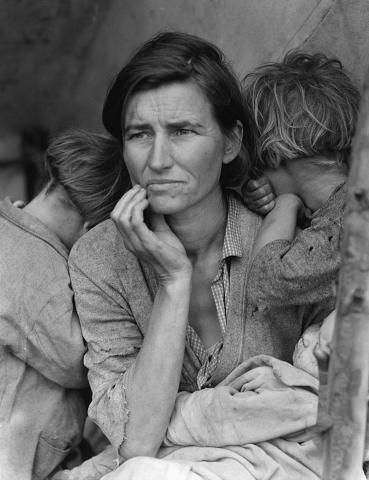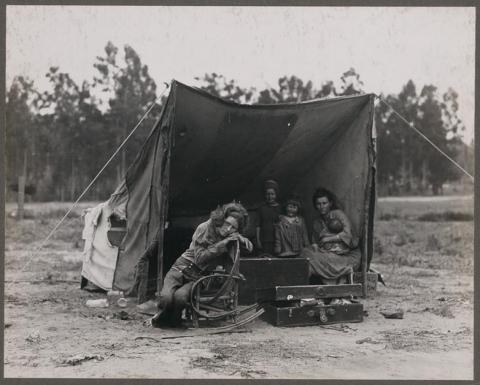After careful thought, we will be discontinuing the Music Monthly newsletter.
Dustbowl Mona Lisa
Dustbowl Mona Lisa
10 Aug 2020
Dustbowl Mona Lisa
As the United States sank into the Great Depression, 22 year old Dorothea Lange took a job as a photographer for the Resettlement Administration, a New Deal agency tasked with helping poor families relocate. One day she found herself in Nipomo, California, at a campsite full of out-of-work pea pickers. The crop had been destroyed by freezing rain; there was nothing to pick. Lange approached one of the idle pickers, a woman sitting in a tent, surrounded by her seven children, and asked if she could photograph them. From Lange's notes:
I did not ask her name or her history. She told me her age, that she was 32. She said that [she and her children] had been living on frozen vegetables from the surrounding fields, and birds that the children killed. She had just sold the tires from her car to buy food.
Her subject, Florence Owens Thompson, allowed Lange to photograph her family because she thought it might help the plight of the working poor. Lange took six pictures and one of them, Migrant Mother, became the iconic photo of the Depression, and one of the most familiar images of the 20th century. At the time, the dust-blown interior of the United States was full of families like hers, whom poverty had forced off their land and into a life of wandering. Their poverty was total; they had nothing. Where is her husband, the children's father? She is on her own. There is no help, no protection, and nothing over the horizon but work, want and more wandering. Her worried, vacant expression seems to communicate what we, at our end of history, already know: things were not going to get better for a long, long time.
There are few images as deeply ingrained in the national consciousness as Migrant Mother. Yet for decades, no one knew what had become of this woman and her family. No one even knew her name: Lange never asked, and by the time the photo appeared in a local newspaper, the woman and her family had moved on to the next town.
Finally, in 1978, a reporter from the Modesto Bee found Thompson, (now aged 75), tracking her down to a trailer park outside Modesto, California. Lange had promised Thompson that her photograph would never be published — Thompson wanted to spare her children the embarrassment — but once she was discovered, she revealed her name and told her story. Thompson was born Florence Leona Christie, a Cherokee, in a teepee in Indian Territory, Oklahoma, in 1903. She married Cleo Owens at 17, then moved to California for farm- and millwork. When she was 28 years old and pregnant with her sixth child, her husband died of tuberculosis. For a while, she and her children lived under a bridge. "When Steinbeck wrote in The Grapes of Wrath about those people living under the bridge at Bakersfield — at one time we lived under that bridge. It was the same story. Didn't even have a tent then, just a ratty old quilt.” Thereafter Thompson worked odd jobs of all kinds to keep her children fed. For most of the 1930s, she was an itinerant farmhand, picking whatever was in season. During cotton harvests, as she described in interviews, she would put her babies in bags and carry them along with her as she worked down the rows. She earned 50 cents per hundred pounds picked and said she "generally picked around 450 to 500 [pounds a day]. I didn't even weigh a hundred pounds."
Lange composed the picture carefully, so that the viewer would focus on the mother’s beauty, faded by a life of poverty. With two of her children cowering behind her for protection, hiding their faces, and her youngest cradled in her left arm, resembling a bunch of rags, her situation is manifest. The serious concern on her face, the way her body shields the children, the weight of her head resting on her hand, her fixed gaze, the closeness of the tent — all suggest a person of integrity who is imprisoned by the unfairness of life. Because so many Americans shared this mother’s fate during the Depression, the picture became a symbol of their situation. And because poverty and injustice remain critical social issues today, the picture has become an icon—or a master work – and is often compared to the Mona Lisa.
Illustrations:
Dorothea Lange, ‘Migrant Mother’, 1936, US Library of Congress, Public Domain
Dorothea Lange, “Nipomo, Calif. March 1936. Migrant agricultural worker’s family. Seven hungry children and their mother, aged 32. The father is a native Californian.”
US Library of Congress, public domain
About the Author
Jeni Fraser
JOIN OUR MAILING LIST
Become an instant expert!
Find out more about the arts by becoming a Supporter of The Arts Society.
For just £20 a year you will receive invitations to exclusive member events and courses, special offers and concessions, our regular newsletter and our beautiful arts magazine, full of news, views, events and artist profiles.
FIND YOUR NEAREST SOCIETY
MORE FEATURES
More than twenty members of our Arts Society flew out in October 2025 for a short but fascinating trip discovering th
Year in Review: A Remarkable Year for The Arts Society Mallorca






